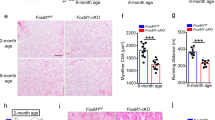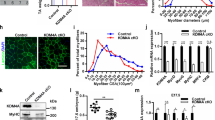Abstract
The discovery of two new p53 homologs, p73 and p63, has defined a family of transcription factors heavily involved in the control of growth suppression, apoptosis, differentiation and development. While p53-deficient mice undergo spontaneous tumors, p73 and p63 knockout mice exhibit severe developmental defects. We demonstrate here that p73 gene is an in vivo transcriptional target of the muscle regulatory factors MyoD, myogenin, Myf5 and Myf6. Ectopic expression of the transcriptional repressor δEF1/ZEB/zfhx1a counteracts MyoD/Myf5- or MyoD/Myf6-mediated transcriptional activation of p73. A distinct pattern of in vivo recruitment of muscle regulatory factors and δEF1 on p73 regulatory regions was found between proliferating and differentiating muscle cells. We also found that δEF1 plays a role in the transcriptional regulation of p53 family members during keratinocytic differentiation. Mouse embryo fibroblasts derived from δEF1-deficient mice exhibit unbalanced expression of ΔNp63, TAp73 and ΔNp73 but not of TAp63 and p53. The analysis of tissues derived from δEF1+/− mice exhibit a selective enrichment of ΔNp63 in skin.
This is a preview of subscription content, access via your institution
Access options
Subscribe to this journal
Receive 50 print issues and online access
$259.00 per year
only $5.18 per issue
Buy this article
- Purchase on Springer Link
- Instant access to full article PDF
Prices may be subject to local taxes which are calculated during checkout





Similar content being viewed by others
References
Bamberger C, Pollet D and Schmale H . (2002). J. Invest. Dermatol., 118, 133–138.
Blandino G and Dobbelstein M . (2004). Cell Cycle, 3, 886–894.
De Laurenzi V, Costanzo A, Barcaroli D, Terrinoni A, Falco M, Annichiarico-Petruzzelli M, Levrero M and Melino G . (1998). J. Exp. Med., 188, 1763–1768.
De Laurenzi V, Rossi A, Terrinoni A, Barcaroli D, Levrero M, Costanzo A, Knight RA, Guerrieri P and Melino G . (2000). Biochem. Biophys. Res. Commun., 273, 342–346.
Fontemaggi G, Gurtner A, Strano S, Higashi Y, Sacchi A, Piaggio G and Blandino G . (2001). Mol. Cell. Biol., 21, 8461–8470.
Fortini ME, Lai Z and Rubin GM . (1991). Mech. Dev., 34, 113–122.
Genetta T, Ruezinsky D and Kadesh T . (1994). Mol. Cell. Biol., 14, 6153–6163.
Jost CA, Marin MC and Kaelin WG . (1997). Nature, 389, 191–194.
Higashi Y, Moribe H, Takagi T, Sekido R, Kawakami K, Kikutani H and Kondoh H . (1997). J. Exp. Med., 185, 1467–1480.
Kaghad M, Bonnet H, Yang A, Creancier L, Biscan JC, Valent A, Minty A, Chalon P, Lelias JM, Dumont X, Ferrara P, McKeon F and Caput D . (1997). Cell, 90, 809–819.
Lai Z, Rushton E, Bate M and Rubin GM . (1993). Proc. Natl. Acad. Sci. USA, 90, 4122–4126.
Lundell MJ and Hirsh J . (1992). Dev. Biol., 154, 84–94.
Mills AA, Zheng B, Wang XJ, Vogel H, Roop DR and Bradley A . (1999). Nature, 398, 708–713.
Morena A, Riccioni S, Marchetti A, Polcini AT, Mercurio AM, Blandino G, Sacchi A and Falcioni R. . (2002). Blood, 100, 96–106.
Postigo AA and Dean DC . (1997). EMBO J., 16, 3935–3943.
Takagi T, Moribe H, Kondoh H and Higashi Y . (1998). Development, 125, 21–31.
Yang A, Schweitzer R, Sun D, Kaghad M, Walker N, Bronson RT, Tabin C, Sharpe A, Caput D, Crum C and McKeon F . (1999). Nature, 398, 714–718.
Yang A, Walker N, Bronson R, Kaghad M, Oosterwegel M, Bonnin J, Vagner C, Bonnet H, Dikkes P, Sharpe A, McKeon F and Caput D . (2000). Nature, 404, 99–103.
Yang A and McKeon F . (2002). Nat. Rev. Mol. Cell. Biol., 1, 199–207.
Acknowledgements
We are grateful to M Oren, D Lane, D Dean and M Crescenzi for plasmids and antibodies. This work was supported by Telethon (n.GGP030358), Italian Association for Cancer Research (AIRC), by Ministero della Salute, by MIUR-FIRB Italy, by Italia-USA and by EC FP6 funding (Contract 503576). This publication reflects the authors' views and not necessarily those of the European Community. The EC is not liable for any use that may be made of the information contained herein. AD is recipient of EMBO long-term fellowship.
Author information
Authors and Affiliations
Corresponding author
Rights and permissions
About this article
Cite this article
Fontemaggi, G., Gurtner, A., Damalas, A. et al. δEF1 repressor controls selectively p53 family members during differentiation. Oncogene 24, 7273–7280 (2005). https://doi.org/10.1038/sj.onc.1208891
Received:
Revised:
Accepted:
Published:
Issue Date:
DOI: https://doi.org/10.1038/sj.onc.1208891
Keywords
This article is cited by
-
Fascia is the “sensor” for the coupling response of manipulative therapies
Journal of Acupuncture and Tuina Science (2024)
-
The role of the ZEB1–neuroinflammation axis in CNS disorders
Journal of Neuroinflammation (2022)
-
miR-205 regulates basement membrane deposition in human prostate: implications for cancer development
Cell Death & Differentiation (2012)
-
EMT-activating transcription factors in cancer: beyond EMT and tumor invasiveness
Cellular and Molecular Life Sciences (2012)
-
The miR-200 and miR-221/222 microRNA Families: Opposing Effects on Epithelial Identity
Journal of Mammary Gland Biology and Neoplasia (2012)



